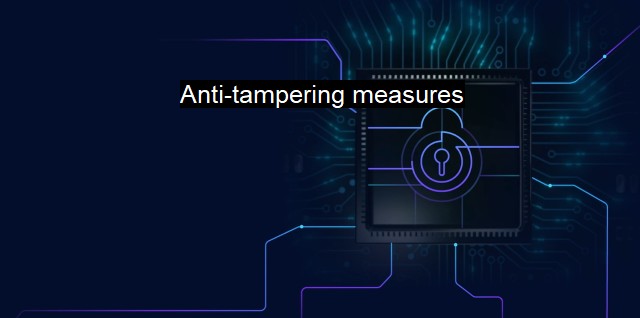What are Anti-tampering measures?
Ensuring Digital Data Security: The Significance of Anti-Tampering Measures in Cybersecurity
Anti-tampering measures, within the scope of cybersecurity and antivirus operations, refer to a cluster of methods, protocols, and practices designed to thwart any unauthorized modifications, alterations, or interference with software, hardware, or an electronic device. In today's fast-growing digital epoch, technologies are in triage against hacking and unwanted intrusion attacks. Therefore, the application of anti-tampering covers a broad range from video games, digital rights management, automotive systems, defence technologies and most importantly, cybersecurity, antiviruses.Anti-tampering measures act as the vanguard in maintaining software integrity and system stability. These tools enable users to identify whether any alteration of the system was attempted. But their reach is beyond a mere alert system. They can safeguard user information, provide data protection, safeguard system control repositories, provide high data integrity levels, maintain systems' robustness under adversity, and support the blockchain.
One might wonder why anti-tampering measures became quintessential. Cyber offenders often sneak into networks or systems by penetrating weak security parameters. They may also attempt to exploit vulnerabilities to change the behavior of the system or to inject or exfiltrate data. These potentially harmful alterations could lead to the unauthorized control of a system, tragic less of personal or classified data, performance degradation, or subsystem malfunctions. Hence, anti-tampering instruments ensure system security by monitoring and highlighting any such potential intrusion.
The mixed combination of encryption, obscuration, code reordering, tracking/data monitors, checksum creation, and execution checks/copies become the habitually adapted anti-tampering techniques. Strong encryption plays an important role in data protection. Basically, the encoded form of data—ciphertext—is meaningless and unreadable unless it's decrypted using the correct key. This is particularly robust for data security during transmission and storage.
Code reordering is a rather innovative approach where the sequence of steps in a program's code is altered without impacting the output. Another popular technique, checksum creation, validates data integrity by producing a unique identification of data that changes whenever the data is manipulated.
Implementation of other advanced anti-tampering tools such as hardware approaches that involve locks and seals or signature-based approaches like intrusion detection systems tap onto further abstract domains of cybersecurity. They combine security measures with the necessary informatics to implement a hands-on approach to exceptional prevention, detection, evaluation, response, and recovery practices for system protections.
Another recently emerged anti-tampering protection method, invoked under active integrity is runtime application self-protection (RASP). RASP aims at responding in real-time to possible tampering approaches when a system is in operations, instead of reaction solely based on input like traditional intrusion detection systems.
Ever drove past a "speed check traffic camera" sign? That is an analog paradigm of anti-tampering innovation. Although the video cameras also record traffic violations, they serve primarily to reinforce drivers avoid tampering with the speed directives. Identically the active threat of anti-tampering measures strengthens a hacker's aversion.
Beyond securing systems, anti-tampering methods are witnessing innovative applications in sectors such as blockchain technologies, Internet of Things (IoT), and even social networking platforms. Today, trust-building, transparency, and privacy become the all-new economy scales.
Anti-tampering measures appear a colossal bulwark against unwanted intrusions. Breaching through this security citadel requires exceedingly high tenacity and considerate resource impoundment—an affordable winning price to the defenders. Thus, drops the invasion ratio, thereby sprucing the digital world's integrity, trust, and security. Consequently, balancing these magnitudes of system protection from unauthorized modification with efficient functionality truly attests to the Pegasus of present-age smart-system builders.

Anti-tampering measures FAQs
What are anti-tampering measures in the context of cybersecurity?
Anti-tampering measures refer to security features implemented to prevent unauthorized access or modification of critical data in computer systems. These measures include encryption, authentication, and access controls.Why are anti-tampering measures important in antivirus software?
Anti-tampering measures are crucial in antivirus software as they help prevent hackers and malware from disabling or modifying the antivirus program's functionality. This ensures that the antivirus software continues to protect the system from various threats.What are some common anti-tampering techniques used in antivirus software?
Common anti-tampering techniques used in antivirus software include process protection, code signing, memory protection, and self-healing mechanisms. These techniques ensure that the antivirus program remains operational and effective against malicious attacks.How can I ensure that my antivirus software has effective anti-tampering measures?
To ensure that your antivirus software has effective anti-tampering measures, look for products that have been independently tested and certified by recognized cybersecurity organizations. Also, make sure to keep your antivirus software up-to-date with the latest security patches and updates.| | A | | | B | | | C | | | D | | | E | | | F | | | G | | | H | | | I | | | J | | | K | | | L | | | M | |
| | N | | | O | | | P | | | Q | | | R | | | S | | | T | | | U | | | V | | | W | | | X | | | Y | | | Z | |
| | 1 | | | 2 | | | 3 | | | 4 | | | 7 | | | 8 | | |||||||